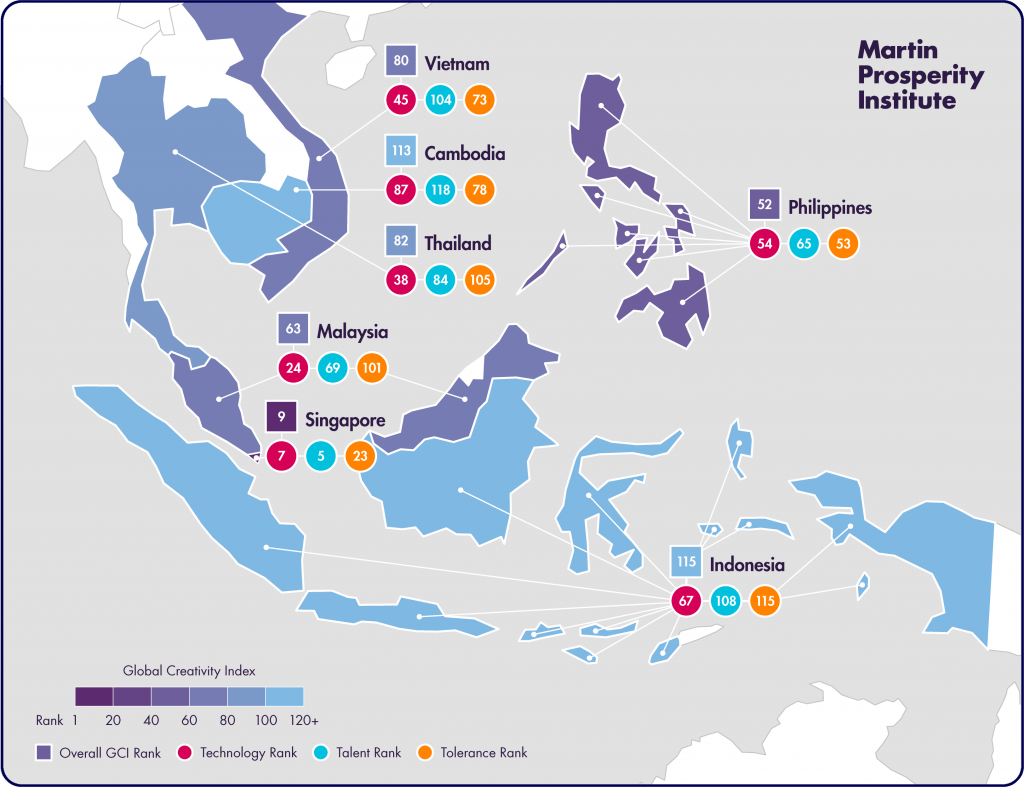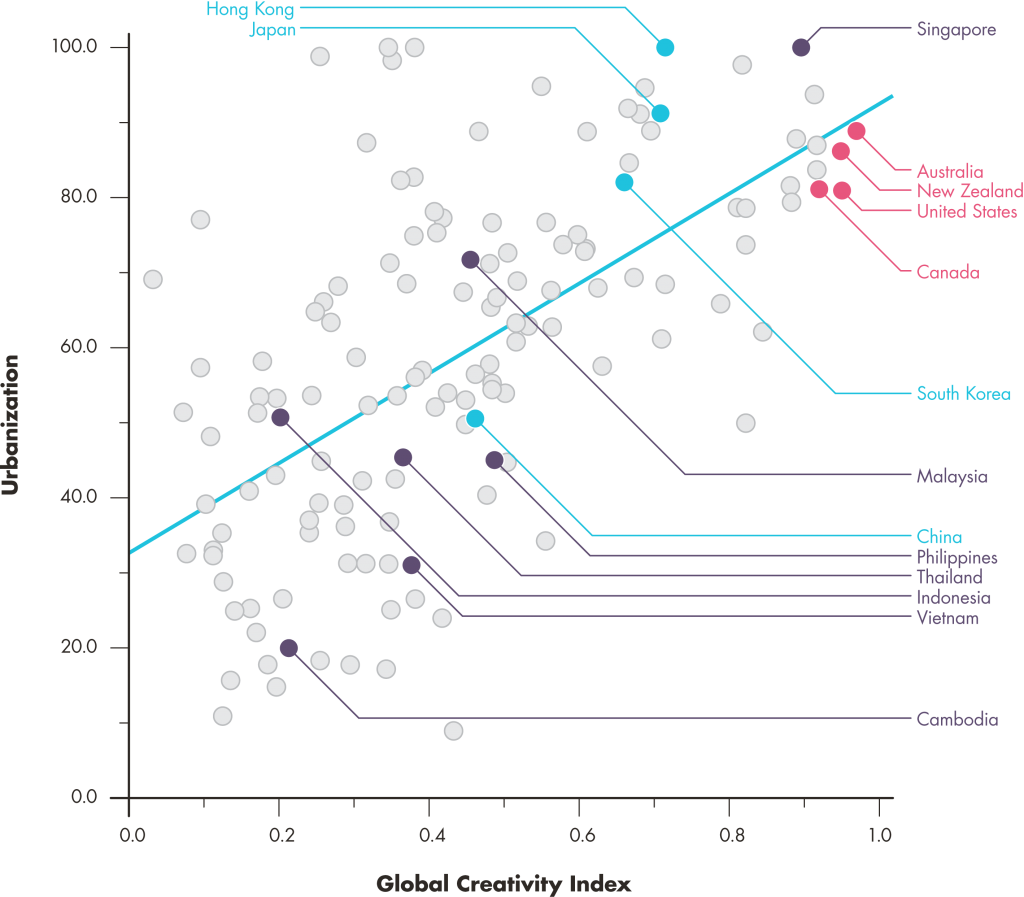Southeast Asia is one of the world’s fastest urbanizing regions. Long seen as a center for lower-cost manufacturing, the region is bound up in the broader transformation from an industrial economy to a creative one.
This Insight examines how the seven Southeast Asian nations — Cambodia, Indonesia, Malaysia, the Philippines, Singapore, Thailand, and Vietnam — stack up on the 2015 edition of the Martin Prosperity Institute’s Global Creativity Index, or GCI, which compares the performance of these seven countries to the 139 nations covered by the report. It examines their performance on the creative class, on the 3Ts of economic development — talent, technology, and tolerance which provide a key barometer of economic performance in the creative economy — and on our overall GCI ranking.
The map below shows how each of these nations perform on the overall GCI and each of the 3Ts.
The Global Creativity Index
The Global Creativity Index, or GCI, is our combined measure of creative economic performance based on all 3Ts.
It reflects a sharp divide in the region. Singapore numbers among the top ten performers in the world, ranking ninth. The Philippines (52nd) and Malaysia (63rd) rank in the middle of the pack. Vietnam (80th), Thailand (82nd), and especially Cambodia (113th) and Indonesia (115th), rank much lower.
Across the rest of Asia, Hong Kong ranks 21st, Japan 24th, South Korea 31st, and China 62nd.
The Creative Class
The creative class includes workers in science and technology and engineering; arts, culture, entertainment, and the media; business and management; and education, healthcare, and law.
Again the region’s divide is evident. Singapore ranks third, with the creative class making up 47 percent of its workforce. In the middle of the pack are Malaysia in 49th (24 percent) and the Philippines at 56th (21 percent). Closer to the bottom, Thailand and Vietnam are 81st and 82nd (both at about 10 percent), Indonesia is 86th (8 percent), and Cambodia is 90th (4 percent).
Across the rest of Asia, Hong Kong ranks 24th (37 percent), Japan is 64th (19 percent), and South Korea is 78th (12 percent).
Talent
Talent is driving force in economic growth. The Global Talent Index combines our measure of the creative class with a measure of educational attainment based on enrollment in post-secondary, or tertiary education.
Singapore ranks fifth, among the world’s top performers like the United States, Australia, and Finland and ahead of Canada. The Philippines (65th) and Malaysia (69th) rank around the middle of the pack. Thailand (84th), Vietnam (104th), Indonesia (108th), and Cambodia (118th), all rank much lower.
Elsewhere in Asia, Hong Kong ranks 32nd, South Korea 50th, Japan is 58th, and China is 87th.
Technology
Technology is a fundamental driver of innovation and the growth of the knowledge economy. The Global Technology Index is based on two measures: a measure of R&D effort (the share of GDP devoted to R&D) and a measure of innovation (patents per capita).
Singapore ranks seventh alongside nations like Australia, New Zealand, and Germany. Malaysia (24th), Thailand (38th), Vietnam (45th), and the Philippines (54th) rank around the top third of all nations. Indonesia (67th) and Cambodia (87th) rank much lower.
Across the rest of Asia, South Korea and Japan rank first and second in the world ahead of Israel and the United States. China is 14th and Hong Kong is 32nd.
Tolerance
Tolerance is the third T. Tolerance acts on economic development by helping to establish the broad context for both technological innovation and talent attraction. Places that are open to different kinds of people gain an edge in both attracting talent from across the spectrum and mobilizing new ideas. Tolerance thus forms an additional source of economic advantage that works alongside technology and talent. Our Global Tolerance Index is based on two measures: openness to ethnic and religious minorities and openness to gay and lesbian people.
The Southeast Asian nations lag on tolerance. Singapore is in 23rd place. The Philippines (53rd), Vietnam (73rd), Cambodia (78th), rank in the middle of the pack. Malaysia (101st), Thailand (105th), and Indonesia (115th) rank much lower.
Across the rest of Asia, Hong Kong is 30th, Japan is 39th, Korea is 70th, and China placed 96th.
Urbanization and Creativity in Southeast Asia
There is a close relationship between urbanization and creativity, with more urbanized nations scoring higher on the GCI. The graph below shows how Southeast Asian nations lineup in terms of the connection between urbanization and the GCI.
Again we see the stark divide in the region. Singapore, in the upper right hand corner of the graph, stands out for its combination of high levels of urbanization and creativity. Cambodia is at the opposite corner in the very bottom left of the graph, with low levels of urbanization and of creativity. Malaysia, the Philippines, Thailand, Indonesia, and Vietnam occupy more of a middle ground.
The Martin Prosperity Institute would like to acknowledge the generous support from Manulife that helps to make our research possible.

